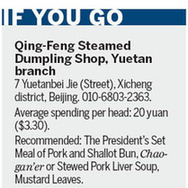
The bun shop is more than 60 years old and was previously called Wanxingju, before changing to its current name in 1976.
The restaurant's oldest outlet was located at Xidan Dajie, but it was demolished in 1999 and relocated to Xi'anmen.
In the following years, the number of branches quickly expanded from three to more than 180. It is now the biggest specialized bun chain restaurant in Beijing.
The more popular buns include pork and shallot, the ones the president ordered, although other varieties also sell well.
Chaogan'er, or stewed pork liver soup, is a typical Beijing snack food made with pork liver and intestines in a thick, starchy broth heavily flavored with garlic.
This dish is of Manchurian origin and was consumed after religious rituals.
The liver stew is a favorite for local Beijingers but not popular for visitors to the capital.
When US Vice-President Joe Biden visited Beijing in August 2011 and ate at Yao's Chaogan'er Restaurant near the Drum and Bell Tower, he ordered pork buns, zhajiang noodles and cucumber salad but avoided the signature liver stew for which the eatery is famous.
Baozi, or steamed buns, are a popular snack in restaurants and households throughout China, but every region has its own variation.
In Tianjin, the Goubuli bun shop has been famous for 150 years, and, like Qing-Feng, the buns are northern Chinese style, made with lots of leeks and pork.
In Shanghai, at the Old Chenghuang Miao, the steamed buns are equally famous, with fillings made from Shanghainese bokchoy and pork.
But the flavor of the moment is buns from Qing-Feng.